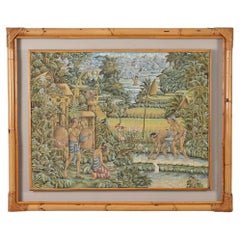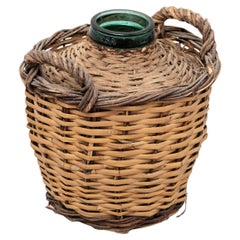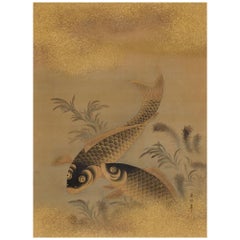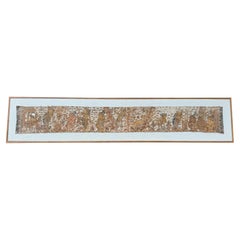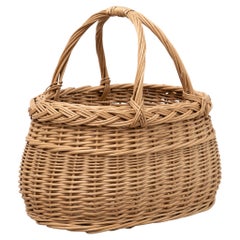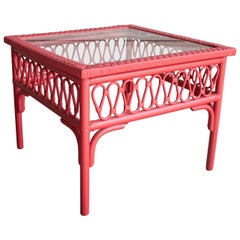Wicker Paintings
to
2
2
2
Height
to
Width
to
2
2
2
1
3,360
9,265
8,615
8,035
6,387
2
1
1
2
2
2
Material: Wicker
Mid-Century Balinese Painting on Silk with Bamboo and Woven Rattan Frame, 1960s
Located in Roma, IT
Spectacular large Balinese Painting on Silk with an outstanding bamboo and woven rattan frame. This marvellous painting was realized in Bali around the 1960s and is signed on the bot...
Category
Mid-20th Century Italian Mid-Century Modern Wicker Paintings
Materials
Bamboo, Wicker, Cane, Rattan, Silk, Glass, Paint
$1,842 Sale Price
20% Off
Antique Vase with Wicker Basket – By Unknown Artist, Circa 1960
Located in Barcelona, ES
Antique Vase with Wicker Basket – By Unknown Artist, Circa 1960
Add a touch of rustic elegance to your space with this antique vase, featuring a beautifully crafted wicker basket, c...
Category
1960s Spanish Mid-Century Modern Vintage Wicker Paintings
Materials
Wicker
$478 Sale Price
55% Off
Related Items
Japanese Painting, Hanging Scroll, Mid 19th Century, Koi and Water Plants
By Iwase Hirotaka
Located in Kyoto, JP
Iwase Hirotaka (1808-1877)
Koi and Water Plants
Hanging scroll, ink, color, gold wash and gold flecks on silk
Inscription: Hirotaka
Seal: Ille...
Category
1860s Japanese Edo Antique Wicker Paintings
Materials
Silk
$6,500
H 56.5 in W 21.5 in D 0.75 in
Bali Hindu Textile Framed 'Kamasan' Painting, Indonesia C. 1900
Located in Jimbaran, Bali
This Antique Balinese Kamasan painting, rendered on handwoven cotton, beautifully captures the timeless elegance of classical Wayang-style storytellin...
Category
Early 1900s Balinese Folk Art Antique Wicker Paintings
Materials
Cotton, Paint
$1,360 Sale Price
20% Off
H 58.47 in W 12.21 in D 1.97 in
Bali Hindu Textile Framed 'Kamasan' Painting, Indonesia C. 1950
Located in Jimbaran, Bali
A mid-20th century 'Kamasan' cotton textile painting from Bali, Indonesia. The hand-painted image has great detail and depicts Balinese Hindu mythology. Key features of this image ar...
Category
1950s Balinese Folk Art Vintage Wicker Paintings
Materials
Cotton, Paint
Japanese Painting, Hanging Scroll, 19th Century Bamboo in Moonlight
Located in Kyoto, JP
Bamboo in moonlight
Gamo Rakan (1784-1866)
Hanging scroll, ink on silk.
Dimensions:
Scroll: 201 cm x 58 cm
Image: 137 cm x 45 cm
In this early 19th century work by Gamo Rakan a light ink wash applied to the silk background silhouettes the moon and suggests the atmosphere of early evening. Even though it is a literati subject, Rakan’s bamboo is quite realistic with a strong decorative style. The painting finds its inspiration from Chinese Ming dynasty painters who often used a single-tone, jet black stroke to emphasize the calligraphic nature of bamboo.
In a different era, decorative would have been seen as somewhat unrefined. But increasingly in the Edo period, it was the hallmark of high style. The Japanese people, in particular the rising merchant class, had gradually become apathetic toward the traditional Sesshu and Kano schools of painting. Chinese professional and amateur painters living in the port of Nagasaki during the 18th century had a profound effect on Japanese painting and the freshness of their style and its decorative appeal contributed greatly to its popularity. Gamo Rakan’s teacher, Tani Buncho...
Category
Early 19th Century Japanese Edo Antique Wicker Paintings
Materials
Silk
Bali Hindu Textile Framed 'Kamasan' Painting, Indonesia, Early 20th Century
Located in Jimbaran, Bali
An early 20th century 'Kamasan' cotton textile painting from Bali, Indonesia. The hand-painted image has great detail and depicts Balinese Hindu mythology. It has been framed with a ...
Category
Early 20th Century Balinese Folk Art Wicker Paintings
Materials
Cotton, Paint
$1,480 Sale Price
20% Off
H 44.49 in W 59.45 in D 1.97 in
Japanese Framed Silk Painting, Turtledoves and Peaches, Taisho Era, circa 1920
Located in Kyoto, JP
Nakamura Daizaburo
Turtledoves in a Peach Tree
Taisho period, circa 1920
Framed painting. Mineral pigments, ink and gofun on silk
Signed: Daizaburo
Dimensions (framed)...
Category
1910s Japanese Taisho Vintage Wicker Paintings
Materials
Wood, Silk
$18,000
H 35 in W 37.5 in D 1 in
Unknown Flemish Artist, 18th Century
Located in Belmont, MA
Unknown Flemish Artist, Belgium 18th century, in the right part of the painting the artist represented a man sitting in front of a tavern. He is surrounded by Delft baroque earthenware pitchers and plates. The right side of the painting shows different types of birds, among them chicken, a swan, ducks and a peacock. The painter was here definitely inspired by the 17th century painter Melchior de...
Category
1770s Belgian Baroque Antique Wicker Paintings
Materials
Hardwood
19th Century Japanese Silk Painting by Kano Chikanobu, Peacock & Bamboo
Located in Kyoto, JP
Birds & Flowers of the Seasons
Pheasants & Plum in Snow
Unframed painting. Ink, pigment and gofun on silk
Kano Chikanobu 1819-1888
Signature...
Category
Mid-19th Century Asian Edo Antique Wicker Paintings
Materials
Silk
$4,500
H 46 in W 19.5 in D 0.01 in
Abstract Geometric Painting, Unknown Artist, 1950s
Located in Antwerp, Antwerp
Original geometric abstract painting from the 1950s, composed of layered angular forms in blue, ochre, and pale pink, set against a bold red background. The work has a strong sense o...
Category
1950s French Mid-Century Modern Vintage Wicker Paintings
Materials
Wood
17th Century Korean Grapevine and Squirrel Scroll Painting, Mid Joseon Period
Located in Kyoto, JP
Anonymous. Korean, 17th century. Joseon period.
Hanging scroll. Ink on paper.
Seal: Shinso
Dimensions:
Scroll: H. 200 cm x W. 31 cm (79” x 12”)
Image: H. 122 cm x W. 29.5 cm (48” x 11.5”)
The grapevine came to China and then Korea from western Asia via the silk road trade routes. By the mid-Joseon period, it was one of the most popular subjects for Korean literati painters. Grapevines were painted as a singular subject or, less commonly, in combination with squirrels, which are associated with children due to their playful nature. Together, grapevines and squirrels embody wishes for abundant offspring and wealth.
For the Korean literati artist the twisting vines, curling tendrils and round, plump grapes provided ample opportunity for expressive "brush play”. In this painting the artist has abstracted the scene and is seemingly unconcerned with discontinuities and proportion. Vines spring up from nowhere, grapes hang in random clusters and the squirrel’s head appears as if twisted backwards. For the vines and leaves we can feel a sense of speed in the brushstrokes, imparting a dynamic feel which is at once intense and animated. This contrasts dramatically with the countless tiny strokes of ink which realistically capture the texture of the squirrel’s fur...
Category
17th Century Korean Other Antique Wicker Paintings
Materials
Paper
$18,000
H 79 in W 12 in D 1 in
19th Century Japanese Screen for Tea-Ceremony, Ink Bamboo and Plum on Gold Leaf
Located in Kyoto, JP
Three Friends of Winter
Nakajima Raisho (1796-1871)
Late Edo period, circa 1850
Ink and gold leaf on paper.
This is a double-sided Japanese Furosaki or tea-ceremony screen from the mid 19th century; bamboo and plum on the front, young pines the back. It by Nakajima Raisho, a master painter of the Maruyama school in the late Edo and early Meiji periods. In this work Raisho combines exquisite ink brushwork with large open spaces of brilliant gold-leaf to inspire the viewers imagination. Rather than naturalism, he is searching for the phycological impression of the motifs, resulting in abstraction and stylization. His simplification of the motifs the result of looking to capture the inner nature of the objects. This art motif is known as Sho Chiku Bai, or the Three Friends of Winter. Evergreen pine connotes steadfastness, bamboo suggests both strength and flexibility, while plum blossoms unfurling on snow-laden branches imply hardiness. Combined, this trio is emblematic of Japanese new year. Chinese literati were the first to group the three plants together due to their noble characteristics. Like these resilient plants flowering so beautifully in winter, it was expected of the scholar-gentleman to cultivate a strong character with which he would be able to show the same degree of perseverance and steadfastness even during times of adverse conditions.
The screen would have been placed near the hearth of a room used for the Japanese tea ceremony, shielding the fire from draughts and also forming a stimulating and decorative backdrop behind the tea utensils. It would have been used in the Hatsugama, or first tea-ceremony of the new year.
Nakajima Raisho (1796-1871) originally studied under Watanabe Nangaku before entering the school of Maruyama Ozui. He was the highest ranking Maruyama school painter at the end of the Edo period and was known as one of the ‘Four Heian Families’ along with Kishi...
Category
Mid-19th Century Japanese Edo Antique Wicker Paintings
Materials
Gold Leaf
$9,200
H 29 in W 74 in D 0.75 in
Unknown Scandinavian Artist, Oil on Canvas, Abstract Composition, 1960s
Located in København, Copenhagen
Unknown Scandinavian artist. Oil on canvas. Abstract composition. 1960s.
The canvas measures: 80 x 60 cm.
The frame measures: 6 cm.
In excellen...
Category
1960s Scandinavian Modern Vintage Wicker Paintings
Materials
Canvas
$900
H 25.99 in W 33.86 in D 1.19 in
Previously Available Items
Antique Wicker Basket, circa 1970
Located in Barcelona, Barcelona
Antique wicker basket.
By unknown artist, circa 1970.
In original condition, with some visible signs of previous use and age, preserving a ...
Category
1970s Spanish Vintage Wicker Paintings
Materials
Wicker, Glass
1980s Spanish Red Lacquered Lace Wicker Square Side Table with Glass Top
Located in Marbella, ES
1980s Spanish red lacquered hand woven lace wicker square side table with glass top.
Category
1980s Spanish Vintage Wicker Paintings
Materials
Wicker
H 20.48 in W 26.38 in D 26.38 in
1950s Painting on Cloth with a 1970s Wicker Frame
Located in Marbella, ES
1950s painting on cloth with a 1970s wicker frame.
Category
Mid-20th Century Indian Wicker Paintings
Materials
Fabric, Wicker
